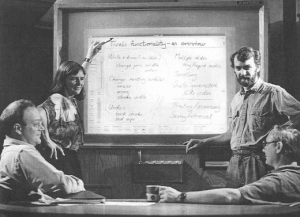Some of my most exciting times have been in small groups grappling with a shared problem. In these sessions ideas seem to pop into view and the creation of insights can be accelerated. Why is idea creation in small groups sometimes so effective and exciting? Can technology enhance this? This core interest is about creating methods and technology for small group idea sessions.
Over a period of months as a member of Joshua Lederberg’s molecular genetics laboratory at Stanford in the early 1970’s, a team of scientists carried out a series of experiments. An unpublished working paper documents observations of that small team. As you might expect for a story about science, the team followed a scientific method with its logic, side trips and adventure. Their path however, was not just mapped out in their minds. The journey was much too complex for that. They worked through a search space of hypotheses and experimental tests using diagrams and other external representations to discuss and plan their joint work. Josh was aware of the importance of this and pointed to a 1964 paper by John Platt describing the crucial use of blackboards and rigorous hypothesis testing. Laboratories that did that made the fastest progress.
When cognitive scientists study a person working through a problem using drawings or writings, they call it “external cognition” to describe how the writings augment the memory of the person and how our perceptive faculties aid understanding. When a team collaborates around shared diagrams, the diagram content expands to include information from all of them. The notes and scribbles from one person trigger insights for another.
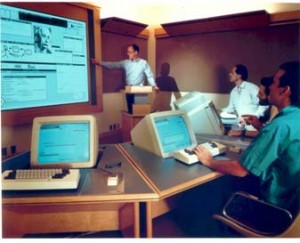 Later at PARC on a team that designed computing systems, we used whiteboards to support our ideation. We became frustrated with the limitations of whiteboards for capturing, organizing and saving ideas. Although white boards held external symbols, they have many limitations. Of course they are not good for keeping an historic record since they were frequently erased. Beyond that they are inconvenient when you want to move information around to reorganize it. Could we create information technology that was better than whiteboards for enhancing knowledge creation?
Later at PARC on a team that designed computing systems, we used whiteboards to support our ideation. We became frustrated with the limitations of whiteboards for capturing, organizing and saving ideas. Although white boards held external symbols, they have many limitations. Of course they are not good for keeping an historic record since they were frequently erased. Beyond that they are inconvenient when you want to move information around to reorganize it. Could we create information technology that was better than whiteboards for enhancing knowledge creation?
Dan Bobrow, Stan Lanning, Gregg Foster, and I started the Colab project (right) at PARC to create an electronic meeting room that would be better than our whiteboards. Our 1987 Communications of the ACM paper Beyond the Chalkboard describes our innovations in multi-user interfaces and structured work processes. We also presented our designs for technology support for team processes at the 1986 Computer Support for Cooperative Work (CSCW) conference in our paper WYSIWIS Revised. Meetings in the Colab were often intense and invigorating. The Colab (shown above) had a built-in liveboard and workstations set into desks.
The Colab was vastly more interactive than a whiteboard. Of course notes and figures could be moved around, but more than that for brainstorming and outlining, they enabled rapid grouping and linking. This was a radical new kind of groupware for realtime collaboration. There was much coherent parallelism in our meetings. Subgroups would form on their own windows and then recombine. The interactive and visual meeting even changed turn taking:
During the brainstorming phase of Cognoter, the parallel action in proposing ideas reduces the usual verbal communication to coordinate turn-taking and synchronization. Oral conversation tends to drop off radically, since so much of the communication load shifts from ears to eyes. …
Freedom from serial turn-taking may alleviate some of the problems of production blocking (due to the limitation that only one group member can talk at a time) reported by other studies of brainstorming n more conventional media (Diehl & Stroebe, 1987).
In these sessions, we regularly completed tasks such as developing highly detailed outlines for joint papers in meetings of thirty minutes or so. Previously such tasks would typically take us several times as long. We often emerged from these fast-paced technology-boosted meetings, finished, exhilarated, and exhausted.
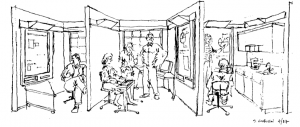 In 1989 John Seely Brown and I extended these ideas beyond real time collaboration meetings to support ongoing knowledge processes in organizations in the paper Toward Portable Ideas.
In 1989 John Seely Brown and I extended these ideas beyond real time collaboration meetings to support ongoing knowledge processes in organizations in the paper Toward Portable Ideas.
The Tivoli group at Parc (Left to right: Frank Halasz, Elin Rønby Pedersen, Kim McCall, Tom Moran in 1991) explored systems for formal and informal meetings, using a more movable version of the Colab “liveboard”. They developed a range of gestural interactions for interacting with the board creating an interactive medium that could be located in labs or conference rooms without needing a dedicated electronic meeting room like the Colab.
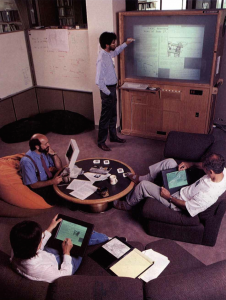 This work helped to set the stage for Mark Weiser‘s vision of ubiquitous computing, with liveboards and also devices the size of tablets, phones, and badges (shown on the left).
This work helped to set the stage for Mark Weiser‘s vision of ubiquitous computing, with liveboards and also devices the size of tablets, phones, and badges (shown on the left).
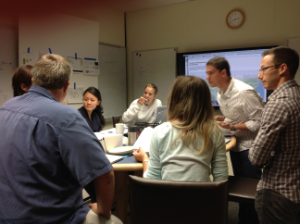 The picture on the right shows a recent meeting of a design team in the TAO group at PARC working in our design lab.
The picture on the right shows a recent meeting of a design team in the TAO group at PARC working in our design lab.
Projects: Colab, digital convergence, innovation practices
Books: Breakthrough, Internet Dreams

